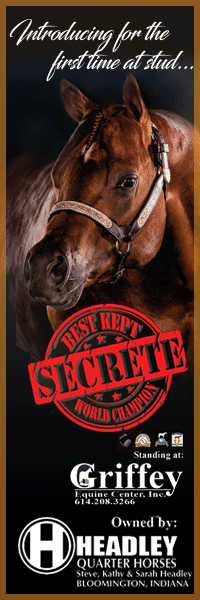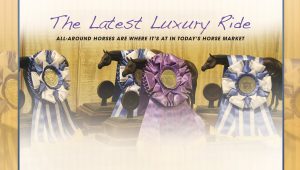The Latest Luxury Ride
Click here to read the complete article
Gone are the days of the horse that did ten different classes before lunchtime. Over the past decade, the trend has undoubtedly shifted towards even more specialization with riders often having multiple horses: a rail horse that specializes in movement, a pattern horse with athletic maneuvering skills, and perhaps even a fun horse for ranch-type classes.
However, the latest and most sought-after “specialty horse” can cross over from the Western Pleasure pen into the all-around field, and those horses are gaining in popularity and price, with good reason. For one thing, a horse that’s already a desirable mover on the rail will always possess a plus-earning advantage over the single event horse that’s simply sure-footed over poles or capable of fancy spins in Horsemanship.
The top professionals in the industry know this horse well, whether they are the trainers with the much-desired Western Pleasure horse or the trainers recognized for the all-around horse. Read on for their perspectives about the desirable foundation and traits of the latest standard in the all-around show pen and how that horse fits into the big picture of the industry.
Changing Tides
When asked if it’s true that the industry tide has begun to shift to include an all-around horse with Western Pleasure beginnings, trainer Shannon Curl Holbin says the observation is 100-percent accurate.
Holbin, who trains with her husband, Chris, at Holbin Show Horses in Vero Beach, Florida, explains that as trainers who mainly focus on Western Pleasure horses, they’ve become a frequent source for all-around trainers searching for the next big thing for their clients. “The Western Pleasure horse foundation is extremely important for the all-around,” she says. “You have to be able to move a horse’s shoulders and hips, adjust their ribcages, and all of the fundamentals to create an all-around horse. I believe that the Western Pleasure horse is that product,” she says.
Even though the practice of turning the Western Pleasure horse into an all-around mount has become a rather hot ticket, trainer Troy Lehn says the practice is not a foreign concept at all. “We trainers have added events to the Western Pleasure horses for quite a while,” he explains.
Lehn, who owns Empyre Show Horses in Pilot Point, Texas with trainer Brad Ost, notes the process of taking a rail horse into the all-around makes a lot of sense. “We like having a horse with a Western Pleasure background, because a good foundation of body control easily translates into future events,” he says. “Whenever they come out of a Western Pleasure program, their body parts have been broken up under saddle, so that’s one step we don’t have to go back and revisit.”
Arturo Maestas, who trains together with Jesse Jones at Maestas Show Horses in Pilot Point, Texas, says he’s seen a shift for many horse owners in all three breeds he trains: Paint, Quarter, and Appaloosa. “Because of the economy, a lot of people can’t afford to have specialty horses like they used to,” he clarifies.
Maestas says the Western Pleasure horse can go on to add Horsemanship, Western Riding, Showmanship, and Trail, as well as Equitation. He explains that while adding other events to a Western Pleasure foundation horse may result in losing a bit of the Western Pleasure advantage for riders, most are pleased because they still have a horse that’s competitive enough to place in their Western Pleasure classes in addition to the all-around events.
Desirable Traits











